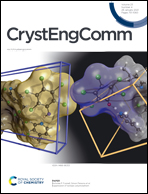Displacement parameters from density-functional theory and their validation in the experimental charge density of tartaric acid†
Abstract
Based on an X-ray diffraction experiment at high resolution and a multipole refinement, the experimental electron density for R,R-tartaric acid (1) was determined. The consistent description of the different hydrogen bonds in 1 confirmed the quality of the diffraction data. The multipole-derived anisotropic displacement parameters (ADPs) for the non-hydrogen atoms were used as benchmarks for ADPs calculated from density-functional theory. For this theoretical approach, the structure was minimized with a dispersion-corrected exchange-correlation functional, and the phonon calculations were performed according to the harmonic and also the computationally more demanding quasiharmonic approximation. ADPs from experiment and quasiharmonic theory match very well with respect to amplitudes and directions of displacement. Numerical and graphical tests for the agreement between experimental and calculated ADPs for all non-hydrogen atoms indicate only small discrepancies. ADPs for hydrogen atoms were validated indirectly by their modest but positive effect on the quality indicators of the diffraction experiment.



 Please wait while we load your content...
Please wait while we load your content...